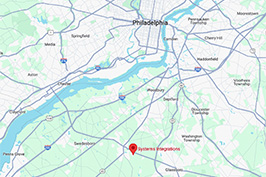The Hidden Danger: Over 40,000 Security Cameras Worldwide Are Exposed to Hackers
How proper installation and configuration can protect your business from becoming the next victim
At Systems Integrations, we’ve seen firsthand how security cameras are meant to protect businesses and homes. But what happens when the very devices designed to keep you safe become a gateway for cybercriminals? Recent research has uncovered a disturbing reality: more than 40,000 security cameras worldwide are completely exposed to the internet, streaming live footage to anyone who knows where to look.
When Protection Becomes Vulnerability
The irony is stark. Surveillance systems installed to enhance security are increasingly becoming the weakest link in business cybersecurity. From manufacturing facilities in New Jersey to office buildings in Philadelphia, internet-connected cameras are being found with zero protection – no passwords, no encryption, no access controls.
These aren’t just theoretical risks. Cybercriminal groups like Akira ransomware have already leveraged exposed cameras to gain initial access to business networks, leading to data theft and ransomware deployment. The Mirai botnet famously recruited over 600,000 compromised security devices to launch devastating distributed denial-of-service attacks.
The Business Impact Is Real
Manufacturing Facilities at Risk
For our manufacturing clients, exposed cameras present unique dangers:
– Industrial espionage: Production lines and proprietary processes visible to competitors
– Operational intelligence: Shift patterns and security routines exposed to bad actors
– Network infiltration: Cameras serving as entry points for lateral movement attacks
Office Environments Under Surveillance
Professional services firms face their own risks:
– Sensitive information exposure: Visible computer screens and confidential documents
– Privacy violations: Employee activities monitored without consent
– Compliance failures: Potential violations of data protection regulations
The Root of the Problem
According to cybersecurity experts, most exposed cameras share common vulnerabilities:
1. Default configurations: Cameras shipped with weak default passwords that are never changed
2. Outdated firmware: Security patches not applied, leaving known vulnerabilities open
3. Poor network segmentation: Cameras placed on main business networks without isolation
4. Forgotten devices: Once installed, cameras are rarely monitored or maintained
John Gallagher, Vice President at Viakoo, notes: “IP cameras are among the most easily hacked devices within an organization because they often are setup without security in mind.”
How Systems Integrations Protects Your Investment
“As a Security solutions engineer holding the Security Industry Association (SIA) Security Industry Cybersecurity Certification (SICC), I’ve implemented secure video surveillance solutions that eliminate these risks.” – David Schulze. Here’s how we ensure your cameras protect rather than expose your business:
Professional Installation Standards
– Secure configuration: All default passwords changed to complex, unique credentials
– Network segmentation: Cameras isolated on dedicated VLANs with restricted access
– Encryption protocols: All data transmission secured with enterprise-grade encryption
– Access controls: Multi-factor authentication required for all administrative access
Ongoing Security Management
– Regular firmware updates: Automated patch management keeps systems current
– Security monitoring: Continuous monitoring for unauthorized access attempts
– Compliance verification: Regular audits ensure systems meet industry standards
– Documentation: Complete security documentation for compliance requirements
NDAA-Compliant Solutions
We exclusively install NDAA-compliant video surveillance equipment from trusted manufacturers like Hanwha, Vivotek, and Rhombus Systems. This ensures your security infrastructure meets federal cybersecurity standards and won’t become a national security risk.
The True Cost of DIY Security
Many businesses attempt to cut costs with consumer-grade cameras and DIY installations. However, the total cost of ownership often exceeds professional solutions when you factor in:
– Breach remediation costs: Average data breach costs exceed $4 million
– Regulatory fines: HIPAA, PCI-DSS, and other compliance violations
– Business disruption: Downtime from ransomware and cyber attacks
– Reputation damage: Customer trust lost from security incidents
Protecting Your Business Today
If you currently have security cameras installed, ask yourself:
– When were the default passwords last changed?
– Is the firmware current with the latest security patches?
– Are the cameras segmented from your main business network?
– Do you have documentation of all camera locations and access credentials?
If you can’t answer these questions confidently, your security system may be exposing your business to unnecessary risk.
Take Action Now
Don’t let your security cameras become a liability. Contact Systems Integrations today for a comprehensive security assessment of your current surveillance infrastructure. Our certified technicians will:
1. Audit existing systems for security vulnerabilities
2. Recommend upgrades to NDAA-compliant equipment
3. Implement proper security controls to protect your investment
4. Provide ongoing maintenance to keep systems secure
Ready to secure your surveillance system?
Call (866) 417-3787 or visit systems-integrations.com to schedule your security assessment.





